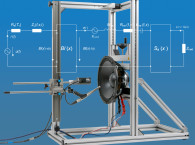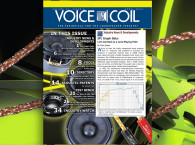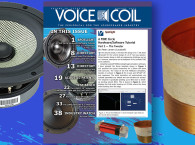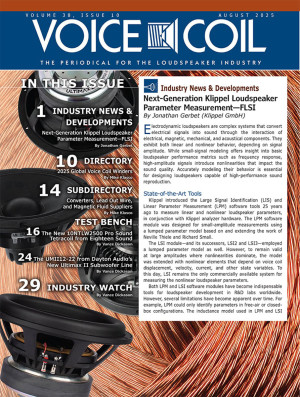 Halfway through the year, Voice Coil continues to offer a unique perspective on the industry for loudspeaker professionals. We start this August 2025 issue with Industry News & Developments, as Jonathan Gerbet tells us everything we need to know about a next-generation Klippel measurement tool — FLSI. Klippel introduced the Large Signal Identification (LIS) and Linear Parameter Measurement (LPM) software tools 25 years ago to measure linear and nonlinear loudspeaker parameters, In conjunction with Klippel analyzer hardware. To advance the state of loudspeaker parameter measurement, Klippel has now developed the Fast Large Signal Identification (FLSI), a new measurement software module designed to replace both LPM and LSI. FLSI delivers faster measurements, improved model accuracy, better automation, and significantly enhanced diagnostic capabilities.
Halfway through the year, Voice Coil continues to offer a unique perspective on the industry for loudspeaker professionals. We start this August 2025 issue with Industry News & Developments, as Jonathan Gerbet tells us everything we need to know about a next-generation Klippel measurement tool — FLSI. Klippel introduced the Large Signal Identification (LIS) and Linear Parameter Measurement (LPM) software tools 25 years ago to measure linear and nonlinear loudspeaker parameters, In conjunction with Klippel analyzer hardware. To advance the state of loudspeaker parameter measurement, Klippel has now developed the Fast Large Signal Identification (FLSI), a new measurement software module designed to replace both LPM and LSI. FLSI delivers faster measurements, improved model accuracy, better automation, and significantly enhanced diagnostic capabilities.As scheduled for this August 2025 issue, Mike Klasco has compiled a valuable directory of Voice Coil Manufacturers and Winders, supplying the latest updates from companies in the US, Europe, and Asia. This is a critical area for loudspeaker manufacturing, and one in which even large-volume companies prefer to cooperate with highly specialized suppliers, while some established loudspeaker driver OEMs have dedicated facilities and R&D teams just for voice coil development and production.
Because voice coil design and manufacturing also depend on a dedicated supply of very specialized materials and solutions, Mike Klasco also prepared an extension of the directory with Converters, Lead Out Wire, and even Magnetic Fluid Suppliers. Some of the vendors listed in this subdirectory are also coil winders, while others are very specialized divisions of very larger material science multinationals. All are essential in the voice coil domain.
For this issue, Vance Dickason worked on the low-frequency domain, characterizing two interesting new woofers from Eighteen Sound and Dayton Audio.
First in Test Bench is the new 10NTLW2500 Pro Sound Tetracoil woofer from Eighteen Sound. An example of the latest production from the Reggio Emilia-based company, now part of B&C Speakers, this new high-power-handling 10" driver is a good example of evolution and refinement in professional audio. As with the 8NTLS2000, a similar transducer featured in the February 2024 issue of Voice Coil, applications for the 10NTLW2500 include use in line arrays, small two-way stage monitors, or as a midbass driver in multiway systems.
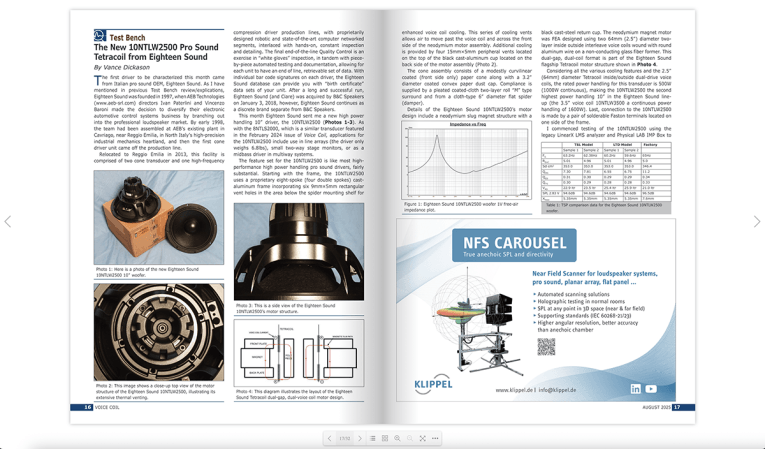
The feature set for the high-power handling 10NTLW2500 is fairly substantial, with vent holes on the cast-aluminum frame, below the spider mounting shelf, and additional cooling provided by four peripheral vents located on the top of the black cast aluminum cup. The cone assembly consists of a modestly curvilinear coated paper cone and dust cap. Compliance is supplied by a pleated coated cloth two-layer roll “M” type surround, and a cloth type 6” diameter flat spider. The 10NTLW2500 motor design includes a neodymium slug magnet structure with a black cast steel return cup, and two 2.5" two-layer inside-outside interleave voice coils, wound with round aluminum wire on a non-conducting glass fiber former - part of the Eighteen Sound flagship Tetracoil motor structure. The rated power handling for this transducer is 500W (1000W continuous), making the 10NTLW2500 the second highest power handling 10” in the Eighteen Sound lineup, after the 3.5” voice coil 10NTLW3500, with a continuous power handling of 1600W.
Next up in Test Bench is the UMII12-22, from Dayton Audio's new Ultimax II Subwoofer Line. Vance Dickason already characterized the UMII8-22 8” model (March 2025) and the UMII10-22 10” (January 2025) model. As with those two drivers, the UMII12-22 12" has a generous feature set that includes a proprietary eight-spoke cast-aluminum frame that is substantial enough to support the heavy motor assembly and incorporates eight trapezoid vents, located below the spider mounting shelf. The mounting shelf itself features a 15mm high standoff to mount the two opposing spiders. Other features include the incorporation of a very stiff and thick curvilinear profile carbon fiber cone, further stiffened by a 4" diameter, 1.25" high heavy paper cone section that attaches to the bottom of the carbon fiber cone to the voice coil neck joint.
For additional thermal cooling, the paper cone extension includes four oval vents with eight more vents at the top of the voice coil former near the neck joint. Suspension/compliance is provided by a low-loss (high Qm) high-profile NBR surround plus two flat 6” diameter cloth spiders. All this is driven by 3" diameter four-layer dual voice coil (two 2Ω coils) wound with flat copper wire on a vented aluminum former. The motor system uses two ferrite magnets sandwiched between a milled and polished front plate and T-yoke that utilizes a flared pole vent surrounded by eight peripheral vents that exhaust from the gap area. The UMII12-22 also incorporates a set of dual aluminum shorting rings — one being an aluminum sleeve on the inner diameter of the motor magnets and the other as a cap on the pole piece that reduces distortion caused by eddy currents.
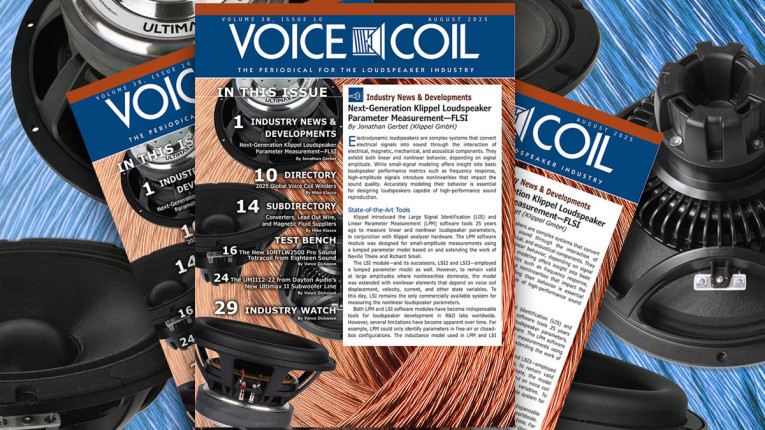
And as always, this issue August 2025 of Voice Coil includes an Industry Watch section, where this month Vance Dickason selected relevant updates from Listen and the Audio & Loudspeaker Technologies International (ALTI) association. Vance also promotes Dr. Floyd Toole’s upcoming book Sound Reproduction, which will soon see the release of the 4th edition, now expanded with contributions by Sean Olive and Todd Welti, both part of the original Harman research and development team.
Remember, Voice Coil is available in print and download for all registered subscribers, free for industry professionals. To qualify for a free subscription to Voice Coil, or to renew your subscription, go to: Voice Coil Subscriber Services.
Subscribers can go to - www.gotomyvcoil.com - to download this issue.
To access the digital subscription platform, just log in using your subscriber number and post/zip code as displayed on your mailing label.



